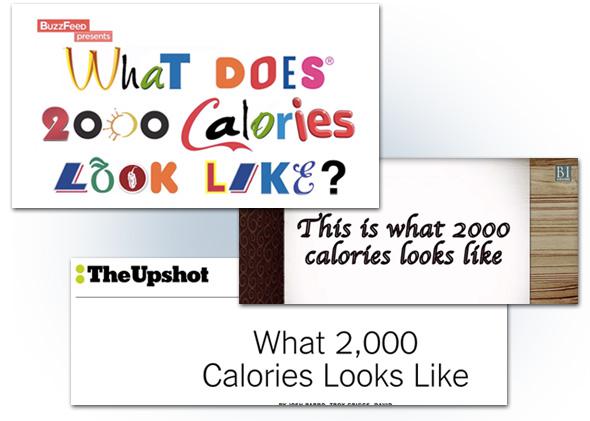Shortly after being published on Monday, the multimedia story “What 2,000 Calories Looks Like” shot to the top of the New York Times’ most-read and most-emailed articles lists. That readers would warm to this article, a production of the data blog the Upshot, is unsurprising. After all, it features gorgeous, full-width photographs of appetizing food—both homemade and from chain restaurants—and it relates to the so-called “obesity epidemic,” one of Times readers’ favorite topics. What is surprising is that the Times—usually a bastion of good taste and restraint in an Internet culture fueled by clickbait—would stoop to publish such an unoriginal and intellectually dishonest piece of work.
One problem with the Times article? It is really, really late to the game. Health magazines and general interest websites have published features essentially identical to “What 2,000 Calories Looks Like” for years. BuzzFeed, in fact, made a video showing what 2,000 calories worth of different foods looks like just last March. Business Insider did a nearly identical video just a few weeks later.
You may also recall a spate of 2013 articles about what 200 calories of food looks like. A year or so before that, Glamour did “What 100 Calories of Your Favorite Halloween Candy Actually Looks Like.” Lifehack’s version was “What 500 Calories Really Looks Like in Different Foods.” Splitting the difference, the health website Sparkpeople has a 300-calorie version. The genre is so common that The Toast recently ran a spoof headlined “What 100 Calories Really Looks Like” that featured Goya’s Saturn Devouring His Son and a still from “The Itchy and Scratchy Show,” among other absurdist examples.
Perhaps it’s not fair to begrudge the Times its late-breaking addition to this genre—after all, very little of what’s published on the Web is entirely original, and the Times’ version clearly aims to make a statement about the contemporary American diet and elicit a reaction from its readers that’s more than just “OMG.” But that statement is what makes the Times version even worse than other photo collections aiming to educate Americans about the relative caloric density of different foods.
The gist of the Times piece is that chain restaurants like Chipotle, Potbelly, McDonald’s, and Olive Garden are guilty of serving “dishes so rich that a single meal often contains a full day’s worth of calories,” i.e., 2,000. (Let’s leave aside the fact that different individuals have wildly different calorie needs and that almost no one needs exactly 2,000 calories a day.) Meanwhile, 2,000 calories’ worth of home-cooked food, according to the Times, is far more satisfying and diversified than a fast-food meal. “We asked James Briscione, the director of culinary development at the Institute of Culinary Education in New York, to prove it by preparing some examples of a day’s worth of home-cooked meals totaling about 2,000 calories, everything included,” explain the Upshot writers.
The problem is that this is a false dichotomy—unhealthy, overly fatty, unsatsifying restaurant food on one side, wholesome, satisfying home-cooked food on the other—that relies on unfair selectiveness on the part of the writers. Sure, they admit, it’s possible to eat a reasonable number of calories at Chipotle by ordering a bowl—but instead of showing you that option, they show you a carnitas burrito with guacamole and chips and a Coke to reach their 2,000 quota.
The food stylist and photographer also went to great lengths to make fairly large amounts of restaurant food look meager. For instance, the Times’ meal from P.F. Chang’s consists of spinach, dumplings, orange beef, pad thai, caramel cake, and wine. I can’t think of anyone, save perhaps a competitive eater or someone coming off a daylong fast, who would eat all that in a single sitting. But the Times’ photo of this food crowds all the plates together to make the spread look “closer to a single meal’s than a full day of food.” Meanwhile, the photographs of the home-cooked foods show it spread out broadly across the full width of the page, which makes the array of food selected look even more expansive than it really is.
But that’s almost beside the point. It should surprise absolutely no one that it is possible to find very high-calories dishes at restaurants, and that it is possible to cook very low-calorie food at home. What the Times doesn’t show is that it’s also possible to eat healthily at restaurants and unhealthily at home. (The next time you’re snacking on cheese and crackers while cooking dinner, or helping yourself to a second helping of homemade granola, try keeping track of calories.)
But neither of these scenarios is particularly relevant to most people—almost no one eats exclusively in restaurants, or exclusively at home. And almost no one orders only the highest-calorie options when they go out to eat, or prepares elaborate meals of chicken, arugula, Brussels sprouts, and squash when they stay in. For most people, figuring out what and where to eat is not a simple choice between McDonald’s and a healthy home-cooked meal—it’s a complex calculus involving time, energy, money, emotions, and cravings. While the Upshot acknowledges that cooking at home “may take more time than fast food,” it doesn’t even begin to address the way people actually eat in real life.
The point is, “What 2,000 Calories Looks Like” doesn’t teach you anything meaningful about the relative merits of eating out versus cooking at home. All it teaches you is that it’s possible to make 2,000 calories look like not a lot of food, but it’s also possible to make 2,000 calories look like a lot of food—it just depends on framing.
